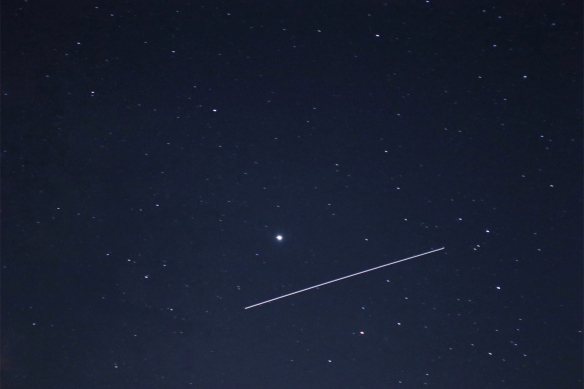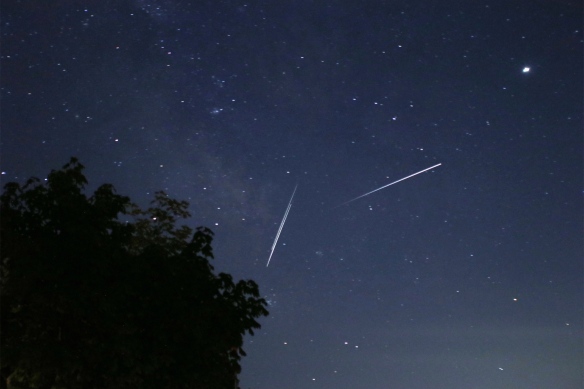Today, I have a Mystery Of The Unknown for you to solve. Unlike most of the puzzlers on this blog, I don’t know the answer.
UPDATE: Mystery solved! See below.
On August 4th at about 20 minutes past 10 PM Eastern Daylight Time I did this 30 second exposure. I am facing south. The bright object in the middle is Jupiter; the orange star below and to its right is Antares. What we have here is the International Space Station flying (from my perspective that night) through the “head” of the constellation of Scorpius from right to left. (Click on the images for a larger view.)
I’ve tweaked the levels in post slightly, for clarity, but basically this is the image I was hoping to get.
I then quickly shifted the camera over to point towards Sagittarius and did an identical 30 second exposure. Again, I’ve tweaked the levels:
And again the bright object is Jupiter. The triangle of stars in the middle of the very bottom of the image is the “stinger” of Scorpius. The M7 cluster to its left is slightly blocked by the tree, and you can see the “lid of the teapot” of Sagittarius following the line of the tree, with the Milky Way emerging as the steam from the teapot.
The ISS is still traveling right to left — west to east — and you can clearly see that the path is much shorter than the previous 30 second exposure because the left end of its travel is where it passed into the shadow of the earth; sunset comes later for the ISS because of its great altitude.
That is again exactly what I expected. The part that I am completely flummoxed by is: what are the two parallel tracks to the left of the ISS going north/south?!?
- I took a third image after this one of the same part of the sky and there is no streak on it of any kind.
- It could be a camera malfunction — but I have never seen such a malfunction. UPDATE: My friend Larry was taking a long exposure at the same time and also captured this exact same streak, so it is definitely not a camera malfunction.
- It could be an atmospheric phenomenon, like a jet contrail being lit up by something. But it does not look like any contrail or cloud I’ve ever seen, and it does not show up in the third image.
- It could be an airplane, but airplanes typically blink in long exposures, or can be seen to have both red and green lights. Also, if it were a single airplane then I would expect the parallel lines to start and end at the same place. And I would expect to see it in the third image.
- It could be a pair of satellites in a polar orbit, but I checked a satellite tracking app and it identified nothing in that neighbourhood except the ISS at that time. (However, I only checked the one app; probably I should check another.) And those “satellites” seem to be in very similar orbits, which seems unlikely. UPDATE: My friend Gord, son of the aforementioned Larry, suggests that it may have been satellites in the Starlink constellation, which travel in pairs. This is now my best hypothesis. I’ll see if I can get some data on Starlink orbits.
- It could be a meteor that has split into two parts that are traveling parallel, and just happened to be in my shot as the ISS entered the shadow of the Earth. Which seems like an extremely unlikely coincidence. Yes, there is a lot of meteor activity in early August, but I’m not buying it.
I have never seen anything like this before. We genuinely have an Unidentified Flying Object here, in that there is some object which is flying but not identified; I rather doubt it is aliens.
Does anyone with more experience than me in photographing satellites have any insight into what I’ve captured here?
Mystery solved by my friend Gord:

The recent Starlink launch put a constellation of 60 satellites into a low orbit, and they’re still all bunched up so it would be common to have two in frame at the same time. That orbit passed right over the Great Lakes region at 10:20 the night I took that exposure, and the direction corresponds as well. Thanks Gord!



https://www.amsmeteors.org/2019/08/meteor-activity-outlook-for-august-3-9-2019/
Yeah, that’s my best guess as well.
My first guess would be perseids, but my second guess would be Starlink Leader/Follower. They’re in polar orbits, and the sunset is appropriately positioned to illuminate them. However I haven’t seen them with magnitude on par with the ISS since they achieved their parking orbits.
That’s really cool, I remember when I got my first camera back in 2007 or so and taking it out to try and get some starry photos, and at one point I was amazed to see a satellite zip across the sky and immediately be followed by another one a few seconds behind it. I ended up asking people on the now-dead BadAstronomy site what it was and they confirmed it’s a fairly common thing!
I’ve tried taking photos of the stars before, and the results are stunning. It’s incredible how many more stars you see in a longer exposed picture. About 6 months ago, (I live in South Africa) we visited a city in the centre of the country. Generally, the outskirts are relatively dark (not as dark as I’d like).
I set up my camera, hoping to get some milky way images that night. I played around with the f-stop’s and took a series of pictures. Before I knew it, I had spent almost 2 hours outside. It’s quite addictive actually, but the ambient light of the nearby city, was messing me around a bit. I still got some nice images though.
The next place I want to try is a secluded beach near Jeffreys Bay called Van Stadens. I’m hoping that it would be darker there. According to the darksitefinder website, there are two blue areas jutting out from the main land to the coast. The quality of images might be better there.
I’ve never captured the ISS on camera before. I think I’ll try doing that next. 🙂
PS: I love spotting Jupiter and pointing it out to the kids.